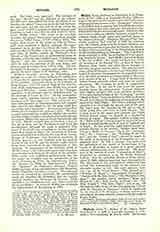

Muller, Karl, professor at Dusseldorf, b. at Darmstadt, October 29, 1818; d. at Neuenahr, August 15, 1893, belongs to the more recent members of a school of German religious painters known as the “Nazarenes”, who succeeded felicitously in popular but beautiful representation of religious devotion, and gave new renown to the Dusseldorf school even in foreign lands. His style, delicate even to softness, exhibits, however, as much naturalness, fresh, simple piety and spiritual peace as the subjects demand. Schadow, director of the Dusseldorf academy, had selected in 1837 the nineteen year old student, along with his brother Andreas, and Deger (who were later joined by Ittenbach), for the contemplated fresco paintings in the Furstenburg church on the Apollinarisberg at Remagen. They had first to study carefully in Italy the technique of fresco painting, then little known. Karl Muller arrived in Rome at the end of 1839. The study and imitation of the art treasures of the Eternal City, as later of those of Florence, Pisa, Assisi, and other places, brought to maturity his great natural talent. His taste for landscape, which he brought with him from Dusseldorf, now found the greatest encouragement; he regarded moreover the study of models as indispensable in the practical exercise of his art. A large circle of German and Italian friends mutually helped each other by artistic excursions. His evenings he spent in composition and the like. At the end of four years the master brought home his characteristic German religious style, lightly mingled with some southern elements. In his principal paintings of the “Crowning” and the “Birth of Mary” (entirely finished in 1850) he showed himself, according to the judgment of connoisseurs, the equal of the elder Deger. The former painting unfortunately is in a bad light the greater part of the year. The lower part, the Apostles by the grave, out of which spring lilies and roses, is widely known. The leading scene in the upper part presents the Virgin Mother bowed before the Savior in a Raphaelite beauty of color. The painter worked so long over the “Birth of Mary” that he hoped to succeed in some degree in satisfying the spirit at once of Raphael and of Dürer. In this work the eight typical women especially deserve to be noticed. Besides these there belong to Muller in the same church the “Annunciation”, the “Visitation”, the “Wedding of the Virgin”, and the “Lamb of God“, adored by angels in the midst of the symbols of the Evangelists on a triumphant arch. In 1859 a contract was made with the authorities of the church of Notre-Dame de La Garde at Marseilles in regard to a great pictorial scheme, unfortunately never carried out. The upper part of the cartoon of a new “Coronation of Mary”, wonderful in execution, is in the Berlin National Gallery. For the cathedral church at Bonn, undertaken in 1866, eighteen paintings were contemplated. The objections of the ecclesiastical authorities also caused this monumental work, to the masters unutterable sorrow, to fail. His easel pictures, however, are all the better known: “The Magnificat“, “Wonder of Roses”, “Immaculate Conception“, “Joseph with the Boy Jesus”, “The Disciples in Emmaus“; the popular round pictures; “Mary and Elizabeth“, the “Holy Family at Work”, also “The Holy Family“, “The Holy Night”, and so on. Of the highest value in art are the altar painting, “Christ with the Disciples at Emmaus,” which he undertook for the church of St. Remigius at Bonn, and his last cartoon for the same church, completed by his nephew Franz Muller.
G. GIETMANN

